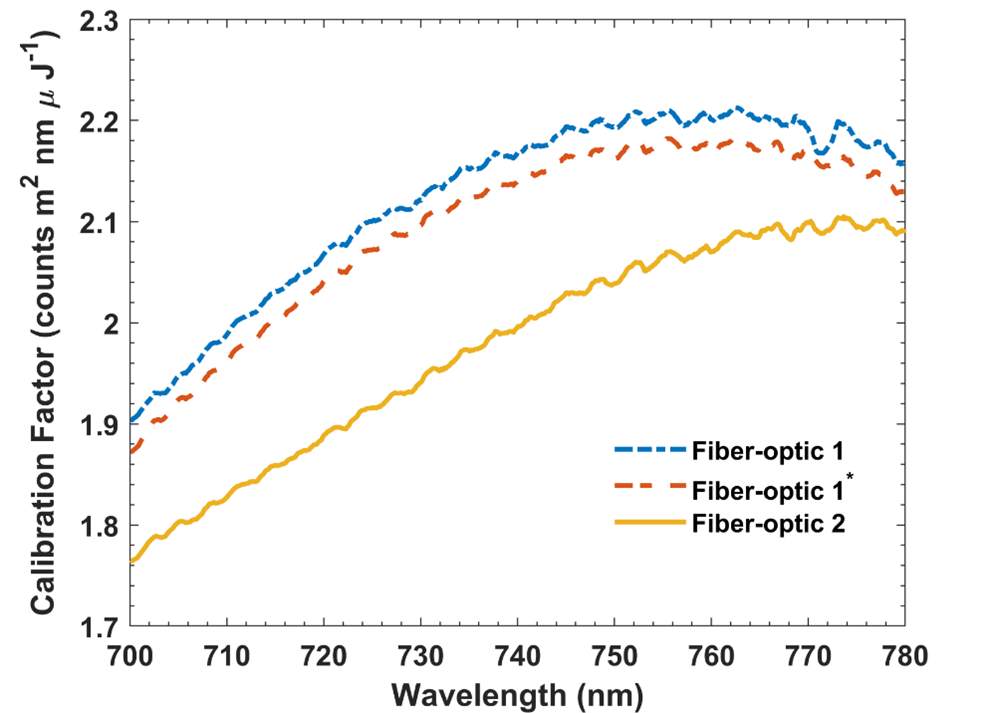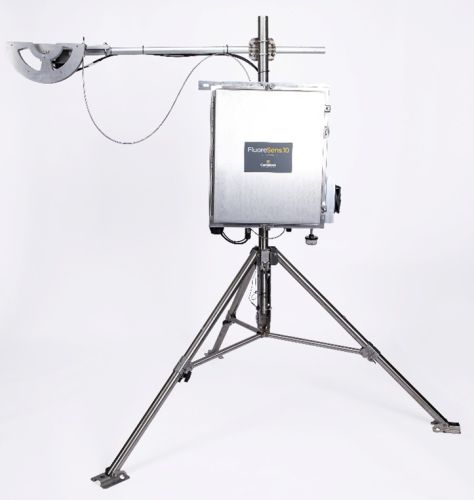Unique Features and Benefits of the FluoreSens™10 for SIF Measurements
by Prajaya Prajapati | Updated: 10/30/2025 | Comments: 0

Monitoring terrestrial photosynthesis at canopy and ecosystem scales is key to improving our understanding of the global carbon cycle, vegetation stress, and climate feedback. Over the past decade, measuring sun-induced chlorophyll fluorescence (SIF) has emerged as one of the most promising tools for quantifying photosynthetic activity in real time. SIF is a faint glow emitted by plant leaves as a byproduct of photosynthesis. Though this light is invisible to the naked eye, it provides a direct window into the workings of the photosynthetic process.
The original SIF system, developed by Dr. Lianhong Gu and his team at Oak Ridge National Laboratory1, demonstrated that canopy-level SIF can reliably track gross primary productivity (GPP) and complement eddy-covariance (EC) flux measurements.
Building on this foundation, the FluoreSens™10 represents the next generation of automated SIF instrumentation. Designed for precision, durability, and field autonomy, the FluoreSens 10 translates a research-prototype concept into a fully integrated, field-ready measurement system that advances pioneering for both ecological and remote-sensing applications.
System Overview and Unique Features
Light-Path Integrity
A key feature of the FluoreSens 10 is its optical path integrity, which is achieved by employing a dedicated fiber optic for each spectrometer and using a rotating fore-optic mechanism to alternately capture downwelling (sky) and upwelling (vegetation) radiation. Because light is never redirected through internal switches or splitters, the radiation strength from the fiber optic to the spectrometer remains unaltered throughout the operation. This is fundamental for accurate SIF retrievals. The spectrometer manufacturer recommends recalibration only when the fiber connection is physically detached or on an annual basis if the connection remains fixed. Consequently, the FluoreSens 10’s optical calibration remains valid year-round, minimizing drift and ensuring consistency in long-term field deployments.

Irradiance spectral response after calibration with the HL-3P-CAL lamp and a fiber-optic cable. The varying responses after unscrewing the same cable (Fiber-optic 1) and reconnecting it (Fiber-optic 1*) or using a different cable (Fiber-optic 2) highlight the importance of maintaining the light path and demonstrate how slight changes in the light path can introduce measurement errors.
Enhanced Spectral and Thermal Stability
The FluoreSens 10 includes a high-resolution spectrometer optimized for the 650–800 nm region, covering the O₂A and O₂B absorption bands vital for SIF retrieval. An optional low-resolution spectrometer (300–1100 nm) covering the visible and near-infrared range can be added for vegetation-index analysis (NDVI, EVI, PRI).
The spectrometers are maintained at approximately −10°C through a dual thermoelectric-cooling (TEC) design that stabilizes the detector temperature and minimizes dark noise. This robust thermal control ensures wavelength stability under fluctuating environmental conditions, enabling precise spectral alignment and repeatability even during continuous, unattended operation.

FluoreSens 10 system mounted on a tripod
Superior Synchronization and Flexibility
At the heart of the FluoreSens 10 is a CR1000-series datalogger that manages all measurement, synchronization, and system control functions. The integrated data logger code guarantees sub‑second temporal synchronization among SIF data and ancillary sensors such as radiation or temperature probes.
Because all scheduling, timing, and acquisition are centralized within the data logger, the system achieves seamless coordination between fluorescence and other ecosystem-level measurements. Researchers can easily add external sensors, which expand the instrument’s capabilities to multi‑variable ecological monitoring and improve data coherence across observational networks.
Rapid Measurement Cycle
The FluoreSens 10 data logger code uses an intelligent control algorithm that automatically optimizes integration times based on ambient light. Under high irradiance, a complete measurement cycle requires approximately four seconds, whereas under cloudy or low-light conditions, it may extend to about one minute.
This dynamic adaptability enables high-frequency temporal sampling of canopy fluorescence and reflectance, capturing fast physiological transitions—such as morning activation, midday depression, or photoprotective responses—that would be under-sampled by slower systems. The result is an exceptionally detailed temporal record of photosynthetic dynamics.
Streamlined Calibration
Calibration and diagnostics are fully integrated into the FluoreSens 10 data logger program. Both spectrometers can be calibrated in situ without the need for external software, using the built-in RTMC Real-Time Monitoring and Control Software. This feature provides users with the flexibility to perform calibration independently, maintaining measurement accuracy and ensuring reproducibility across seasons for long-term deployments in flux-tower or agricultural networks.
Optimized Sampling Geometry and Flux Footprint Matching
Accurately interpreting SIF in relation to carbon fluxes requires spatial alignment between optical and micrometeorological measurements. The FluoreSens 10 achieves this through a cosine‑corrected fore-optic with a 180-degree field of view, providing consistent coverage for both upwelling and downwelling measurements.
This setup produces footprints that closely match the EC flux observation source areas, enhancing the comparability between SIF and carbon-exchange measurements and reducing spatial-scale uncertainty in data interpretation.
Scientific and Operational Benefits
Linking SIF and Carbon Fluxes
By collocating the FluoreSens 10 with EC instrumentation, researchers can quantify the correspondence between SIF and GPP, revealing insights into light-use efficiency and carbon‑assimilation dynamics. Such data help refine terrestrial biosphere models, improving the capacity to predict carbon-cycle feedback to climate change.
Early Detection of Vegetation Stress
Because SIF originates from photosystem II, a light-driven protein system in plant chloroplasts that drives photosynthesis, the FluoreSens 10 SIF measurements can reveal physiological stress responses before visible symptoms appear. Variations in SIF intensity and spectral shape can indicate drought, temperature stress, or nutrient limitations. When combined with vegetative indices, SIF can provide a comprehensive diagnostic framework for plant health monitoring and stress-response research.
Contribution to Ecosystem Science and Remote-Sensing Calibration
Ground-based SIF observations play a crucial role in validating and improving satellite-derived fluorescence data from existing and upcoming satellite missions (e.g., GOSAT, TROPOMI, OCO-2, FLEX). The FluoreSens 10’s continuous observations can provide essential reference data for algorithm development and scaling studies.
By bridging microscale plant physiology with macroscale remote sensing, the FluoreSens 10 enhances our ability to interpret regional and global photosynthetic patterns. The system thus strengthens the link between field observations and satellite-derived fluorescence products, a vital step toward integrating SIF into climate-model frameworks.
Conclusion
The FluoreSens 10 embodies the evolution of SIF technology from research prototype to advanced, field-hardened system. Its optical-path integrity, rapid adaptive measurement cycle, thermal stability, and precise synchronization collectively help enhance ground-based fluorescence monitoring.
By enabling accurate, automated, and continuous canopy-level SIF measurement, the FluoreSens 10 allows researchers to study photosynthetic efficiency, vegetation stress, and carbon flux dynamics with unprecedented detail. Grounded in proven scientific methodology yet engineered for modern operational demands, the FluoreSens 10 represents a significant step forward in observing, understanding, and modeling the Earth’s biosphere, ultimately supporting efforts to monitor ecosystem health and inform climate research.
References
1 Gu, L., Wood, J. D., Chang, C. Y., Sun, Y., & Riggs, J. S. (2019). Advancing terrestrial ecosystem science with a novel automated measurement system for sun-induced chlorophyll fluorescence for integration with eddy covariance flux networks. Journal of Geophysical Research: Biogeosciences, 124(1), 127–146.
















 Dr. Prajaya Prajapati is an Application Engineer/Scientist in the Micrometeorology Group at Campbell Scientific, Inc. Since joining the company in 2022, he has been working closely with the FluoreSens™10 Sun-Induced Chlorophyll Fluorescence (SIF) System and eddy-covariance product line, supporting sales and providing technical support. He holds a doctoral degree in Agronomy, with research focused on micrometeorology, from Kansas State University.
Dr. Prajaya Prajapati is an Application Engineer/Scientist in the Micrometeorology Group at Campbell Scientific, Inc. Since joining the company in 2022, he has been working closely with the FluoreSens™10 Sun-Induced Chlorophyll Fluorescence (SIF) System and eddy-covariance product line, supporting sales and providing technical support. He holds a doctoral degree in Agronomy, with research focused on micrometeorology, from Kansas State University.
Comments
Please log in or register to comment.